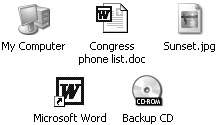1.1. What Is Windows, Anyway? Windows is an operating system , the software that controls your computer. It's designed to serve you in several ways: -
It's a launching bay . At its heart, Windows is a home base, a remote-control clicker that lets you call up the various software programs (called applications in the trade) you use for work or play. When you get right down to it, applications are the real reason you bought a PC. Windows XP is a well-stocked software pantry unto itself. As you'll see later in this book, it comes with such basic programs as a Web browser, email program, simple word processor, and calculator. There's even software to download, print, and edit photos from your digital camera and play music and movies on your PC. If you're like most people, sooner or later, you'll buy and install more software. That's one of the luxuries of using Windows: you can choose from a staggering number of add-on programs. Whether you're a left-handed beekeeper or a German-speaking nun, some company somewhere is selling Windows software designed just for you, its target audience. -
It's a file cabinet . Every application on your machine, as well as every document you create, is represented on the screen by an icon (see Figure 1-1). You can organize these icons into little onscreen file folders. You can make backups (safety copies) by dragging file icons onto a floppy disk or blank CD, or send them to people by email. You can also trash icons you no longer need by dragging them onto the Recycle Bin icon. -
It's your equipment headquarters . What you can actually see of Windows is only the tip of the iceberg. An enormous chunk of Windows is behind-the-scenes plumbing that controls the various functions of your computerits modem, screen, keyboard, printer, and so on. Figure 1-1. Your Windows world revolves around icons, the tiny pictures that represent your programs, documents, and various Windows components . From left to right: the icons for your computer itself, a word processing document, a digital photo (a JPEG document), a word processor program (Word), and a CD-ROM inserted into your computer. 
UP TO SPEED
Service Packs | | As you probably know, Windows is a creature that constantly evolves. Every few weeks, Microsoft issues another bundle of tiny patches: drivers for new add-ons, patches for bugs , seals for newly discovered security holes, and so on. But once a year or so, the company rolls all of these minor updates into one mama patch called a Service Pack. All PCs sold since the fall of 2004 come with Service Packs 1 and 2 pre-installed. This book assumes you have such a machine. Either way, you'll want to get to know Windows XP's Automatic Updates feature (Section 11.5.3), to make sure your PC is always running the latest and greatest version of Windows. |
 |
